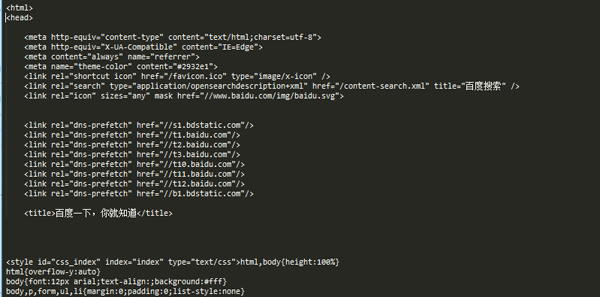最近对python爬虫有了强烈地兴趣,在此分享自己的学习路径,欢迎大家提出建议。我们相互交流,共同进步。
1.开发工具
笔者使用的工具是sublime text3,它的短小精悍(可能男人们都不喜欢这个词)使我十分着迷。推荐大家使用,当然如果你的电脑配置不错,pycharm可能更加适合你。
sublime text3搭建python开发环境推荐查看此博客:
[sublime搭建python开发环境][http://www.cnblogs.com/codefish/p/4806849.html]
2.爬虫介绍
爬虫顾名思义,就是像虫子一样,爬在Internet这张大网上。如此,我们便可以获取自己想要的东西。
既然要爬在Internet上,那么我们就需要了解URL,法号“统一资源定位器”,小名“链接”。其结构主要由三部分组成:
(1)协议:如我们在网址中常见的HTTP协议。
(2)域名或者IP地址:域名,如:www.baidu.com,IP地址,即将域名解析后对应的IP。
(3)路径:即目录或者文件等。
3.urllib开发最简单的爬虫
(1)urllib简介
| Module | Introduce |
|---|---|
| urllib.error | Exception classes raised by urllib.request. |
| urllib.parse | Parse URLs into or assemble them from components. |
| urllib.request | Extensible library for opening URLs. |
| urllib.response | Response classes used by urllib. |
| urllib.robotparser | Load a robots.txt file and answer questions about fetchability of other URLs. |
(2)开发最简单的爬虫
百度首页简洁大方,很适合我们爬虫。
爬虫代码如下:
from urllib import request
def visit_baidu():
URL = "http://www.baidu.com"
# open the URL
req = request.urlopen(URL)
# read the URL
html = req.read()
# decode the URL to utf-8
html = html.decode("utf_8")
print(html)
if __name__ == '__main__':
visit_baidu()
- 1.
- 2.
- 3.
- 4.
- 5.
- 6.
- 7.
- 8.
- 9.
- 10.
- 11.
- 12.
- 13.
- 14.
结果如下图:
我们可以通过在百度首页空白处右击,查看审查元素来和我们的运行结果对比。
当然,request也可以生成一个request对象,这个对象可以用urlopen方法打开。
代码如下:
from urllib import request
def vists_baidu():
# create a request obkect
req = request.Request('http://www.baidu.com')
# open the request object
response = request.urlopen(req)
# read the response
html = response.read()
html = html.decode('utf-8')
print(html)
if __name__ == '__main__':
vists_baidu()
- 1.
- 2.
- 3.
- 4.
- 5.
- 6.
- 7.
- 8.
- 9.
- 10.
- 11.
- 12.
- 13.
- 14.
运行结果和刚才相同。
(3)错误处理
错误处理通过urllib模块来处理,主要有URLError和HTTPError错误,其中HTTPError错误是URLError错误的子类,即HTTRPError也可以通过URLError捕获。
HTTPError可以通过其code属性来捕获。
处理HTTPError的代码如下:
from urllib import request
from urllib import error
def Err():
url = "https://segmentfault.com/zzz"
req = request.Request(url)
try:
response = request.urlopen(req)
html = response.read().decode("utf-8")
print(html)
except error.HTTPError as e:
print(e.code)
if __name__ == '__main__':
Err()
- 1.
- 2.
- 3.
- 4.
- 5.
- 6.
- 7.
- 8.
- 9.
- 10.
- 11.
- 12.
- 13.
- 14.
- 15.
运行结果如图:
404为打印出的错误代码,关于此详细信息大家可以自行百度。
URLError可以通过其reason属性来捕获。
chuliHTTPError的代码如下:
from urllib import request
from urllib import error
def Err():
url = "https://segmentf.com/"
req = request.Request(url)
try:
response = request.urlopen(req)
html = response.read().decode("utf-8")
print(html)
except error.URLError as e:
print(e.reason)
if __name__ == '__main__':
Err()
- 1.
- 2.
- 3.
- 4.
- 5.
- 6.
- 7.
- 8.
- 9.
- 10.
- 11.
- 12.
- 13.
- 14.
- 15.
运行结果如图:
既然为了处理错误,那么***两个错误都写入代码中,毕竟越细致越清晰。须注意的是,HTTPError是URLError的子类,所以一定要将HTTPError放在URLError的前面,否则都会输出URLError的,如将404输出为Not Found。
代码如下:
from urllib import request
from urllib import error
# ***种方法,URLErroe和HTTPError
def Err():
url = "https://segmentfault.com/zzz"
req = request.Request(url)
try:
response = request.urlopen(req)
html = response.read().decode("utf-8")
print(html)
except error.HTTPError as e:
print(e.code)
except error.URLError as e:
print(e.reason)
- 1.
- 2.
- 3.
- 4.
- 5.
- 6.
- 7.
- 8.
- 9.
- 10.
- 11.
- 12.
- 13.
- 14.
- 15.
- 16.
大家可以更改url来查看各种错误的输出形式。



































